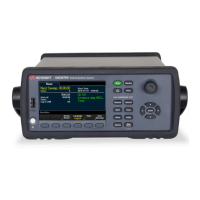Syntax conventions
The format used to show commands is illustrated as below:
VOLTage:DC:RANGe {<range>|MIN|MAX|DEF}
The command syntax shows most commands (and some parameters) as amixture of upper- and lower-case letters.
The upper-case letters indicate the abbreviated spelling for the command. For shorter program lines, you can send
the abbreviation form. For better program readability, you can send the full form.
For example, in the above syntax statement, VOLT and VOLTage are both acceptable forms. You can use upper- or
lower-case letters. Therefore, VolTaGe, volt and Volt are all acceptable forms. Other forms, such as VOL and
VOLTAG, are not valid and will generate an error.
– Braces ( { } ) enclose the parameter choices. The braces are not sent with the command string.
–
A vertical bar ( | ) separates multiple parameter choices. For example, {<range>|MIN|MAX|DEF} in the above com-
mand indicates that you can specify a numeric range parameter, or "MIN", "MAX", or "DEF". The bar is not sent
with the command string.
– Angle brackets ( < > ) indicate that you must specify a value for the enclosed parameter. For example, the above
syntax statement shows the <range> parameter in angle brackets. Do not send the brackets with the command
string. You must specify a value for the parameter (for example "VOLT:DC:RANG 10") unless you select one of the
other options shown in the syntax (for example "VOLT:DC:RANG MIN").
– Optional parameters are enclosed in square brackets ( [ ] ). Thebrackets are not sent with the command string. If
you donot specify a value for an optional parameter, the instrument uses a default value.
SCPI command separators
A colon ( : ) separates consecutive keywords. You must insert a blank space to separate a parameter from a com-
mand keyword. If a command requires more than one parameter, separate adjacent parameters using a comma:
CONF:VOLT:DC 10,0.003
A semicolon ( ; ) separates commands within the same subsystem and can also minimize typing. For example, the fol-
lowing string:
TRIG:SOUR EXT; COUNT 10
... is equivalent to the following two commands:
TRIG:SOUR EXT
TRIG:COUNT 10
Use a semicolon and colon ( ;: ) to link commands from different subsystems. For example, in the following com-
mand string, an error is generated if you do not use both the semicolon and colon:
DISP:TEXT:CLE;:SOUR:CURR MIN
Keysight DAQ970A/DAQ973A Programming Guide 17
1 Remote Operation

